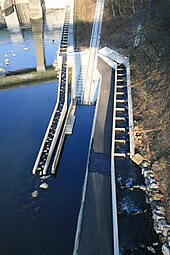Fish pass at Wettingen power station
The Fischaufstieg Kraftwerk Wettingen fish pass is a 600 meter long fish pass (technical German: Fischaufstieghilfe (FAH)) on the Limmat in the municipality of Neuenhof AG , Switzerland . It was built in 2006/07 as part of renovation work on the power plant and is one of the largest of its kind in Europe. Although it is not located in Wettingen , it is identified by its affiliation with the power plant with the name affix Wettingen .
history
Since the Wettingen power station was built in the early 1930s, no further fish migration has been possible below the dam; the water weir was a man-made walking barrier . The river navigation was also interrupted with the construction, but a boat ramp, which could be operated by human hands, provided further travel options. The centuries-long bathing trips would have been possible, but they came to a standstill mainly for other reasons.
In order to preserve the fish species, it was recommended at the time to use 15,000 summer trout or 300,000 young broods above the weir in the canton of Aargau and 2000 trout summer in the canton of Zurich. The extent to which this advice was followed is not documented. Fish ladders were built back then, but such a large vertical offset was not yet known. The euphoric report about the new structure states: “For the current small shipping industry, a barge ramp for pontoons up to 17 meters in length is to be built on the left bank. Since the fish migration stops as a result of the construction of the power station, a fish ladder [would] not be effective with this great gradient ».
location
In the area of the Wettingen power plant, several traffic flows run through the densely populated Limmat Valley , the oldest of which, the migratory movement of shoals of fish, is the most inconspicuous for humans. The oldest human evidence of mobility in this area is the Wettingen-Neuenhof wooden bridge , which dates from 1818 in its current form. But since the end of the 13th century, a ferry connection has been documented as a forerunner. The important north-south railway connection has been crossing the Zurich – Baden line since 1877 , after the previous route on the western bank of the Limmat was abandoned. In the area of the municipality of Wettingen , the route therefore crosses the river twice, while otherwise it always runs west. The construction of the barrier was to be built 50 meters downstream according to the original plans. The pillars of the railway line, which had only been built in lime mortar, would then have stood permanently in the reservoir, which would have required extraordinary structural safeguards. The 168 meter long bridge on the cantonal road between Wettingen and Neuenhof dates from 1967/70 and was built because the old wooden bridge could no longer cope with the growing car traffic. The construction of this bridge is related to the construction of the Baregg Tunnel in terms of timing and traffic planning .
The fish pass is on the Limmat – Wasserschloss industrial culture trail .
technology
The fish passage was built close to nature and with a didactic and public effect. Explanatory boards explain the meaning and purpose of this building in urban space. There is an absolute ban on fishing. The area along the watercourse is fenced in, but several small bridges bring people to the water to awaken their understanding. Overall, the area looks like a small park with access from three directions. In the upper area there are some allotments.
The space in this area is very limited, as the construction of the dam was originally planned right here! In order to overcome the difference in altitude of 18.34 meters, the fish pass in the lower course is initially directed down the Limmat, but then runs up through a narrow bend to the Limmat reservoir. The maximum gradient is 3 percent. 400 liters of water per second flow through the fish passage down the valley, which causes a maximum current of 2 meters per second, but only in the slits between the stone blocks, until the next step there is calmer water. A total of 128 steps with a height difference of 10 to 15 centimeters were installed. In the upper quarter of the fish pass, the water flows like a low mountain stream without any built-in components. A basin was built in the upper area to serve as a counting chamber. «Over fourteen species of fish have already been counted. On certain days up to 400 fish were registered. " ( Pierre-Yves Christen (2009) ) The functionality of the fish passage is also evidenced by the occasional presence of gray herons . A beaver has also been sighted.
Individual evidence
- ↑ a b c Josef Killer: The new power station Wettingen , in: Badener Neujahrsblätter, Vol. 9/1933 , pp. 8-30, doi : 10.5169 / seals-320536 .
- ^ Ernst Woywod: The bridge building for the national highways . In: Moderne Brücken im Aargau , No. 105/1987 , p. 646. doi : 10.5169 / seals-76610
- ↑ The new fish passage at the Wettingen power plant is in operation . On: Anglerbund.ch
- ↑ Pierre-Yves Christen: The longest fish passage in Europe , in: Environment Aargau, Department Landscape and Waters. No. 44, May 2009, p. 11
- ↑ The fish pass at the Chraftwerk Wettige is nöd numme vo Fisch bruuchd. In: Wettiger News. May 22, 2015, accessed on May 22, 2015 (Swiss-German).
Coordinates: 47 ° 27 ′ 20 " N , 8 ° 19 ′ 12" E ; CH1903: six hundred and sixty-six thousand four hundred and sixty-seven / 256458

